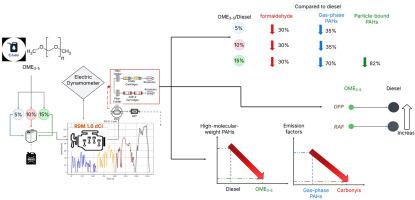甲氧基醚(OME3-5)混合燃料对羰基化合物和多环芳烃无管制有毒排放的影响
IF 6.2
2区 工程技术
Q2 ENERGY & FUELS
引用次数: 0
摘要
甲氧基醚(OMEx)是由氢气和捕获的二氧化碳合成的可再生电子燃料。这些化合物已成为有望减少柴油发动机排放的电子燃料。本研究评估了含有3至5个碳原子的氧甲基醚混合物(OME3-5)对不受管制的有毒排放的影响,重点是羰基化合物和多环芳烃(PAHs)。一台欧6a柴油发动机使用了5%、10%和15%的OME3-5混合物(OME5、OME10和OME15),使用了全球统一轻型车辆测试循环(WLTC)。通过柴油氧化催化剂和颗粒过滤器上游的综合采样方法分析了不受管制的污染物。共分析了16种多环芳烃和13种羰基。研究表明,OME3-5混合物减少了羰基和多环芳烃的排放。甲醛和乙醛被确定为主要的羰基,甲醛排放量减少了30%的混合物。羰基排放因子范围为22.5±3.75 ~ 45±1.7 mg/km,显著高于气态多环芳烃排放因子(~ 20±3 ~ 115±7 μg/km)。当OME3-5浓度增加到15%时,气相和颗粒结合的多环芳烃含量减少了35%至70%,其中高分子量多环芳烃含量显著减少。此外,臭氧形成势(OFP)和呼吸活性分数(RAF)分析表明,与传统柴油相比,OME3-5混合物对大气的影响更小。这些发现强调了OME3-5混合燃料作为电子燃料支持可持续燃料转型的潜力。本文章由计算机程序翻译,如有差异,请以英文原文为准。

Effect of oxymethylene ether (OME3-5) e-fuel blends on unregulated toxic emissions of carbonyl compounds and polycyclic aromatic hydrocarbons
Oxymethylene ethers (OMEx) are renewable e-fuels synthesized from hydrogen and captured carbon dioxide. These compounds have emerged as promising e-fuels to reduce emissions from diesel engines. This study evaluates the impact of oxymethylene ether blends containing three to five carbon atoms (OME3-5) on unregulated toxic emissions, focusing on carbonyl compounds and polycyclic aromatic hydrocarbons (PAHs). A Euro 6a diesel engine was tested with 5 %, 10 %, and 15 % OME3-5 blends (OME5, OME10, and OME15) using the Worldwide Harmonized Light Vehicles Test Cycle (WLTC). Unregulated pollutants were analyzed through a comprehensive sampling methodology upstream of the diesel oxidation catalyst and particulate filter. A total of 16 PAHs and 13 carbonyls were analyzed. The study revealed that OME3-5 blends reduce carbonyl and PAHs emissions. Formaldehyde and acetaldehyde were identified as dominant carbonyls, with formaldehyde emissions decreasing by 30 % across blends. Carbonyl emission factors ranged from 22.5 ± 3.75 to 45 ± 1.7 mg/km, markedly exceeding gaseous PAHs emissions (∼20 ± 3 to 115 ± 7 μg/km). Gas-phase and particle-bound PAHs exhibited reductions ranging from 35 % to 70 % as the OME3-5 concentration increased up to 15 %, with significant reductions in high-molecular-weight PAHs. Furthermore, ozone formation potential (OFP) and respiratory activity fraction (RAF) analyses showed the lower atmospheric impact of OME3-5 blends compared to conventional diesel. These findings underscore the potential of OME3-5 blends as e-fuel to support sustainable fuel transition.
求助全文
通过发布文献求助,成功后即可免费获取论文全文。
去求助
来源期刊

Journal of The Energy Institute
工程技术-能源与燃料
CiteScore
10.60
自引率
5.30%
发文量
166
审稿时长
16 days
期刊介绍:
The Journal of the Energy Institute provides peer reviewed coverage of original high quality research on energy, engineering and technology.The coverage is broad and the main areas of interest include:
Combustion engineering and associated technologies; process heating; power generation; engines and propulsion; emissions and environmental pollution control; clean coal technologies; carbon abatement technologies
Emissions and environmental pollution control; safety and hazards;
Clean coal technologies; carbon abatement technologies, including carbon capture and storage, CCS;
Petroleum engineering and fuel quality, including storage and transport
Alternative energy sources; biomass utilisation and biomass conversion technologies; energy from waste, incineration and recycling
Energy conversion, energy recovery and energy efficiency; space heating, fuel cells, heat pumps and cooling systems
Energy storage
The journal''s coverage reflects changes in energy technology that result from the transition to more efficient energy production and end use together with reduced carbon emission.
 求助内容:
求助内容: 应助结果提醒方式:
应助结果提醒方式:


